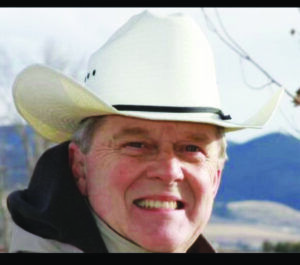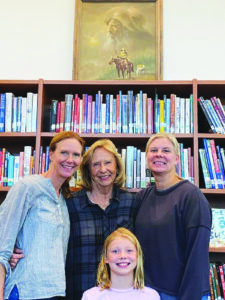
by John Dowd
For some, books seem to be falling by the wayside as a medium for learning. However, for those like the late Gary Habedank and his wife, Kathryn, books are a lost treasure trove of history that comes firsthand from the past. Gary was an avid collector of old books, especially ones regarding Montana history. According to Kathryn, Gary loved Montana, and had the opportunity to collect a number of important pieces before his death, in 2013. Now, Kathryn and the Habedank family are working to put his legacy to work to help keep Montana history alive within the state. They hope Gary’s legacy will further Montana history education across the state, and they have started in the Bitterroot.
Much of Habedank’s collection came from a purchase of a large private library in 2005 from Jerome Cate. Cate’s collection included books by numerous prominent Montana authors, Montana history books, books on Lewis and Clark, Montana artists, state geography and much more. This purchase bolstered Gary’s already growing collection from works he bought online, and from used book stores. After his death, his family has been looking to do something with his collection. According to Kathryn, the family really wants to see the books stay in Montana, and they have reached out to several places, including the University of Montana, in Missoula, all of whom have been interested.
However, getting the books to the college has proven to be a challenge because the university wants to have access to the books, all scanned into a computer programl, so they can view them digitally. This will be very difficult and costly for Kathryn, as she would have had to hire someone to scan them. Because of this, and the fact that they really want to get the books out there, she began looking around at other options.

One caveat with the collection came from its original owner. When Gary purchased the books from Cate, the former owner expressed a desire for all the books to stay together. This would be difficult, unless the entire collection was sold together. The Habedank family felt the next best thing was to keep them in Montana, and to get them to places that would most appreciate them. After Gary died, Kathryn said she had a difficult time finding out what to do with his collection of books, which numbered over 600 individual books. Some of the books are quite old, being original and quite valuable.
After speaking with several locals, including Beverly Welling, owner of Beverly’s Books, and Jane Lambert, author of the book “Charlie Russell: The Cowboy Years,” it was suggested that Kathryn look into donating some of the books to the local schools.
Lambert was the one who suggested the Stevensville school, and Welling was the one who came to see the books and discovered what Kathryn truly had. “She’s like a walking encyclopedia on books,” said Kathryn.
The suggestion to get them into the schools resonated with the Habedank family, who fondly remember Gary’s love for Stevensville. Gary was a retired businessman and financial advisor. According to his wife, he always wanted to write and got into purchasing the books to do research. Gary did end up writing numerous unpublished family letters in which she said he wrote elegantly on things he learned in his research.
“He just loved Montana. He loved the land, he loved the people,” said Kathryn.
Gary grew up in Sidney, Montana, and he and Kathryn met at Pacific Lutheran University, in Tacoma, Washington. She was a music professor there, and he was studying business. The two of them ended up traveling to several other schools, including a stay at the University of Montana, in Missoula.
In 1996, they purchased land in the Stevensville area, where Gary and a few friends of his became what Kathryn referred to as, “gentleman farmers.” However, she finds it comical that she was the only one with any real farming experience, having grown up on a farm herself. She tells stories of how she often had to remind him of the things he needed to do to keep up their farm. According to her, he was also really well-liked among locals in the area, a lot of which had to do with him being from Montana.
According to Kathryn, the locals of the Stevensville area were always so friendly and would do anything for anybody that needed it in the community. Because of this, Kathryn contacted Stevensville High School, which was very interested in looking at the books. The principal at the time, Eric Larson, came out to look at the collection and Kathryn said, “They all were thrilled!” She then worked with the school librarian, Heidi Cohen, and donated 300 books to the school.
According to Cohen, “It was kind of cool to see the older rusty dusty books still have life in them,” once the books made it into the school. Kathryn also donated a historic work of art and a historic photo to the school library, which are currently displayed there. Of the books Kathryn donated to Stevensville, some seven of them are part of a volume set of originals about the Montana Constitutional Convention of 1971-1972. Gary had two of these complete sets, as his father had been one to attend the convention, as was the previous owner of the library, Cate. For Kathryn, “Anytime a state rewrites its constitution, it’s very historical.” She added, “Montana has quite the fine constitution, and many states have modeled their constitutions after it.”
Kathryn and Gary attended several convention reunions, where they got to meet with and speak to some of the original delegates. “It’s fascinating to meet some of these people who rewrote a state constitution,” she said. Kathryn spoke about how hard the convention delegates worked to get everything just right, while sticking to the spirit of the state.
Cohen keeps the convention books on the side, hoping one day to put them into a display as a set. After speaking with the librarian, Kathryn learned the school library did not have a budget, so she also donated money to help get more books for the kids. That money was used on modern books. For the librarian, it is always a challenge to get youth interested in reading books. According to her, the books they purchased with the donation were for “newer publications with cooler covers the kids might actually read.” When asked about the books she looks to include in the library, she explained that a lot of them come from suggestions and requests. She tries to give interested youth every opportunity to have what they want to read and might be interested in, as well as to have reference books they may need.
Though Kathryn and the family donated many books to Stevensville over two years ago, she is still trying to donate many more of the books. Her family still donates money to the school in the town Gary really loved. Kathryn and the family are still working to get the books into the University of Montana, and plan to reach out to other places to donate the books where they will do the most good. Though Cate’s dream of keeping the collection together may not be realized, he may be happy to know that they will likely stay together in the state and be a treat for future generations of Montanans interested in the history of their home.
Mike Archdale says
Wonderful story. I have two concerns. 1. As any library has the issue of limited space. What happens to an individual copy of the collection in 10 or 20 years when the staff does not the history of the collection and discards one or two books of the collection. Minimum requirement the collection reminds the entire collection. No discards or weeding of this collections. If anyone thinks of discarding one copy of this collection. They do not understand or appreciates one little bite the history of Montana history or exceptional books. This one of kind collection. 2. Circulation policy. Will books be checked out of the library or not? Maintain the conditions of the books. No need for missing books, or pages. No need for damaged books.